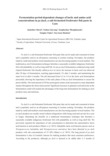Fermentation period-dependent changes of lactic and amino acid concentrations in pa daek, a salt-fermented freshwater fish paste in Laos
JIRCAS Working Report
| ISSN | 1341710X |
|---|---|
| NII recode ID (NCID) | AA11159468 |

Full text
jircas_working_report90-_95-100.pdf726.61 KB
Pa daek is a salt-fermented freshwater fish paste that can be made and consumed at home and is popularly used as an all-purpose seasoning in Laotian cooking. Nowadays, the products made by small and medium-sized manufacturers are also becoming popular in local markets. The traditional pa daek fermentation technique furnishes a seasonally available indigenous freshwater fish with palatability as well as long shelf life. In our pa daek fermentation conducted using small clupeid freshwater fish (locally called pa keo in Laos), the increase in lactic acid was observed after 20 days of fermentation, reaching approximately 1% after 2 months, and maintaining the same level at after 6 months. The pH decreased from 6.3 to 5.4 as the lactic acid fermentation proceeded, showing the importance of the early phase of the pa daek fermentation to secure the preservability. The total amount of 20 free proteogenic amino acids increased in a time-dependent manner throughout the observation period. Significant increases in glutamic acid and lysine in the fermentation could well explain the advantages of the long-term fermentation for making pa daek products tasty and nutritious.
| Date of issued | |
|---|---|
| Creator | Junichiro Marui Yethao Giavang Souphachay Phoupasouk Yanglao Yialee Sayvisene Boulom |
| Publisher | Japan International Research Center for Agricultural Sciences |
| Type | Technical Report |
| NII resource type vocabulary | Technical Report |
| Volume | 90 |
| spage | 95 |
| epage | 100 |
| Language | eng |
